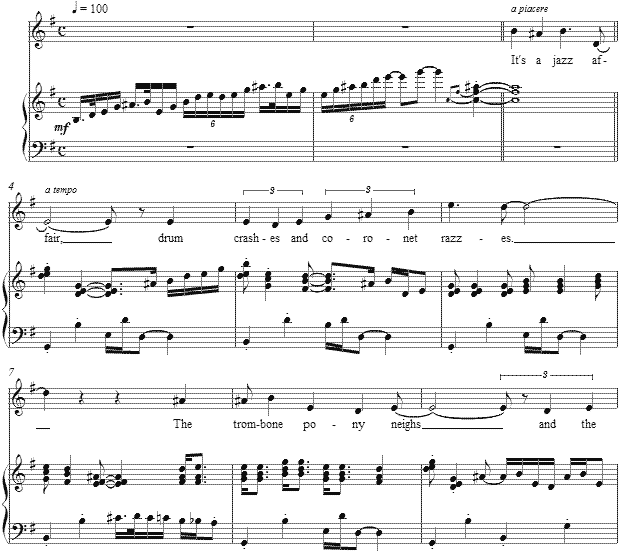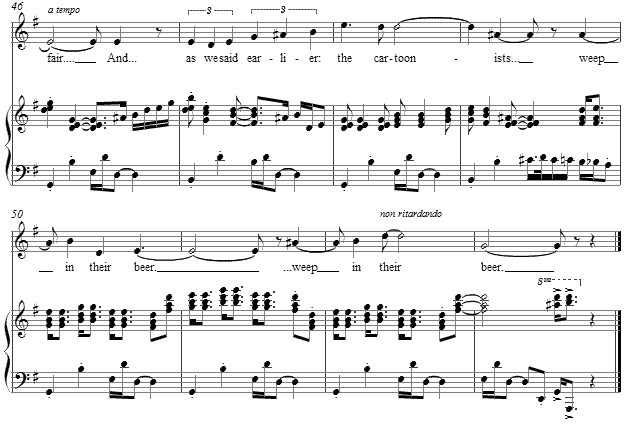Music and Texts of GARY BACHLUND
Vocal Music | Piano | Organ | Chamber Music | Orchestral | Articles and Commentary | Poems and Stories | Miscellany | FAQs
Honky Tonk - (2009)
Carl Sandburg
for medium voice and piano
It's a jazz affair, drum crashes and coronet razzes.
The trombone pony neighs and the tuba jackass snorts.
The banjo tickles and titters too awful.
The chippies talk about the funnies in the papers.
The cartoonists weep in their beer.
Shop riveters talk with their feet
To the feet of floozies under the tables.
A quartet of white hopes mourn with interspersed snickers:
"I got the blues.
I got the blues.
I got the blues."
And . . . as we said earlier:
The cartoonists weep in their beer.[ 4 pages, circa 2' 10" ]
Carl Sandburg
The term, honky tonk, has been traced back at least to The Daily Ardmoreite, February 26, 1894, pg. 2, col. 1. (Oklahoma Historical Society, Microfilm #110). "The honk-a-tonk last night was well attended by ball heads, bachelors and leading citizens. Most of them are inclined to kick themselves this morning for being sold."
The term, honky, seems to be derived from "hunky" and "bohunk," derogatory slang for Bohemian, Hungarian, and Polish immigrants, which was picked up by locals, including blacks in Chicago of Sandburg's time, and applied generally to all "whites." It was noted that W. C. Handy wrote of "Negroes and hunkies" in his Father of the Blues: An Autobiography, edited by Arna Bontemps. New York; Macmillan, (1941). The notion that racial epithets and stereotypical slang is not endemic to all men is foolish. Moreover such words become part and parcel of a language, making it more colorful and expressive over generations.
"Tonk," as the second part of the term, has been said to derive from a line of upright pianos manufactured by William Tonk & Bros. (established 1889), though this has been questioned in terms of dates.
Of the Tonk, one finds "The Tonk piano is everywhere noted for peculiarly sweet and sonorous tone and excellence of workmanship and material. As the product of one of the old-established New York industries whose entire career has been one of strict integrity and honor, it is natural to expect something distinctly good in the Tonk piano. And in this anticipation there is no disappointment, for this piano is of a kind to do credit to any name. In short, the Tonk piano is a sweet-toned, satisfying instrument, is durable and is musical. It is rapidly gaining in sale and also already enjoys a large export trade. The Tonk player-piano and Triplex Electric Player and Reproducing Grands and Uprights are no less satisfactory and their success is firmly established. One of the distinct and thoroughly demonstrated improvements in Tonk pianos and player-pianos is the combination rolled steel back construction. It is a feature that has been tried out and proved of great merit."
As to Tonk's catalogues, one finds: "William & Bro. Importers', manufacturers' and jobbers' catalogue of musical merchandise: piano material & piano stools, etc." New York: William Tonk & Bro.; 1881, a catalogue of musical merchandise, piano materials, piano stools.
The original title of the poem is "Honky Tonk in Cleveland, Ohio," taken from Sandburg's anthology, Smoke and Steel (1920).
Composed in a verse form, the setting fits the unrhymed, prose poem into a sectional form. The first phrase is used as a "curtain" between the sections, as start with measure 4. The opening "riff" is meant to establish the atmosphere, and the accompaniment should be played strictly, as if by a piano roll player, over which the vocal line bends with its drawling triplets and additional syncopations.
The third and truncated repetition of the setting's "verse" is in the subdominant, as the text describes a "quartet of white hopes," which further shows Sandburg's awareness that honky was not only a description of a saloon, a musical genre of sorts, but additional a racial identification.
The last and foreshortened repetition of the musical "verse" returns to the original tonic, with a short coda notated non ritardando. The song should end without dryly comment.
The score for Honky Tonk is available as a free PDF download, though any major commercial performance or recording of the work is prohibited without prior arrangement with the composer. Click on the graphic below for this piano-vocal score.



